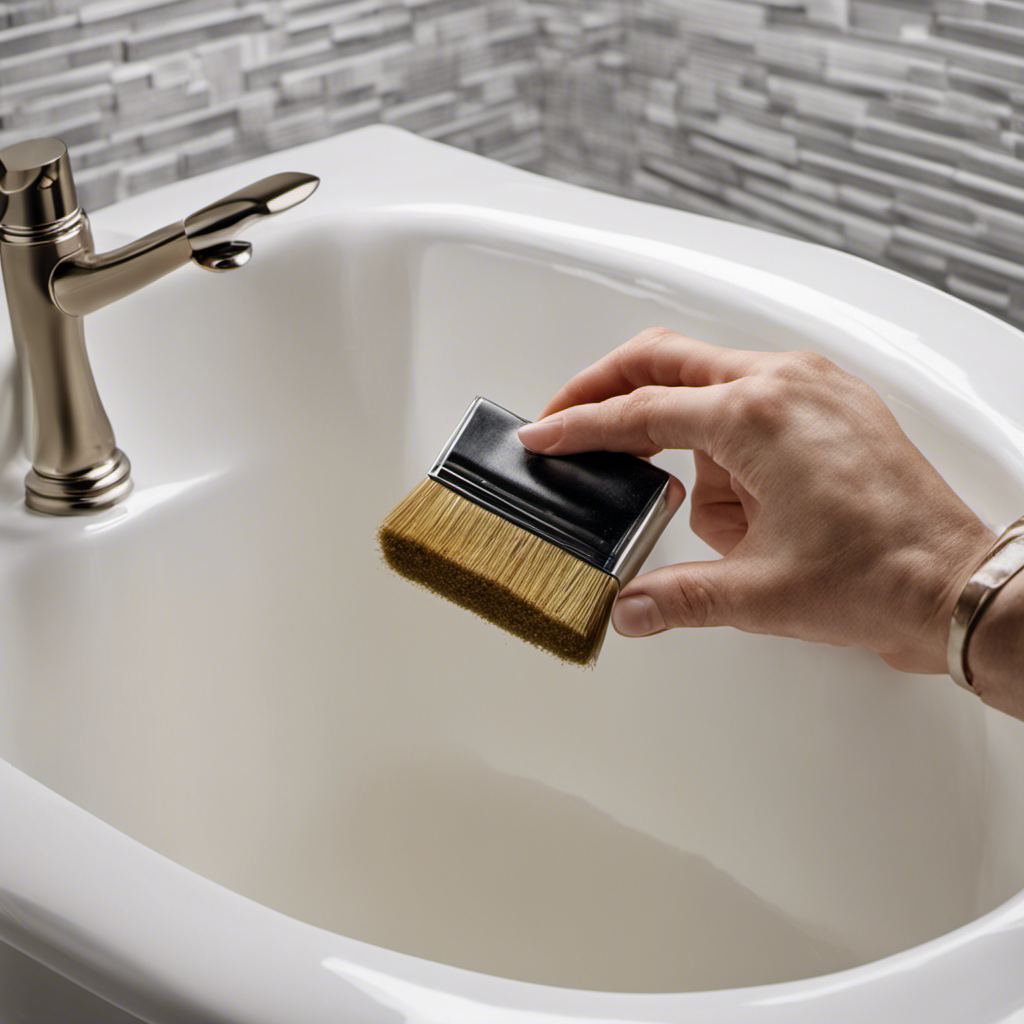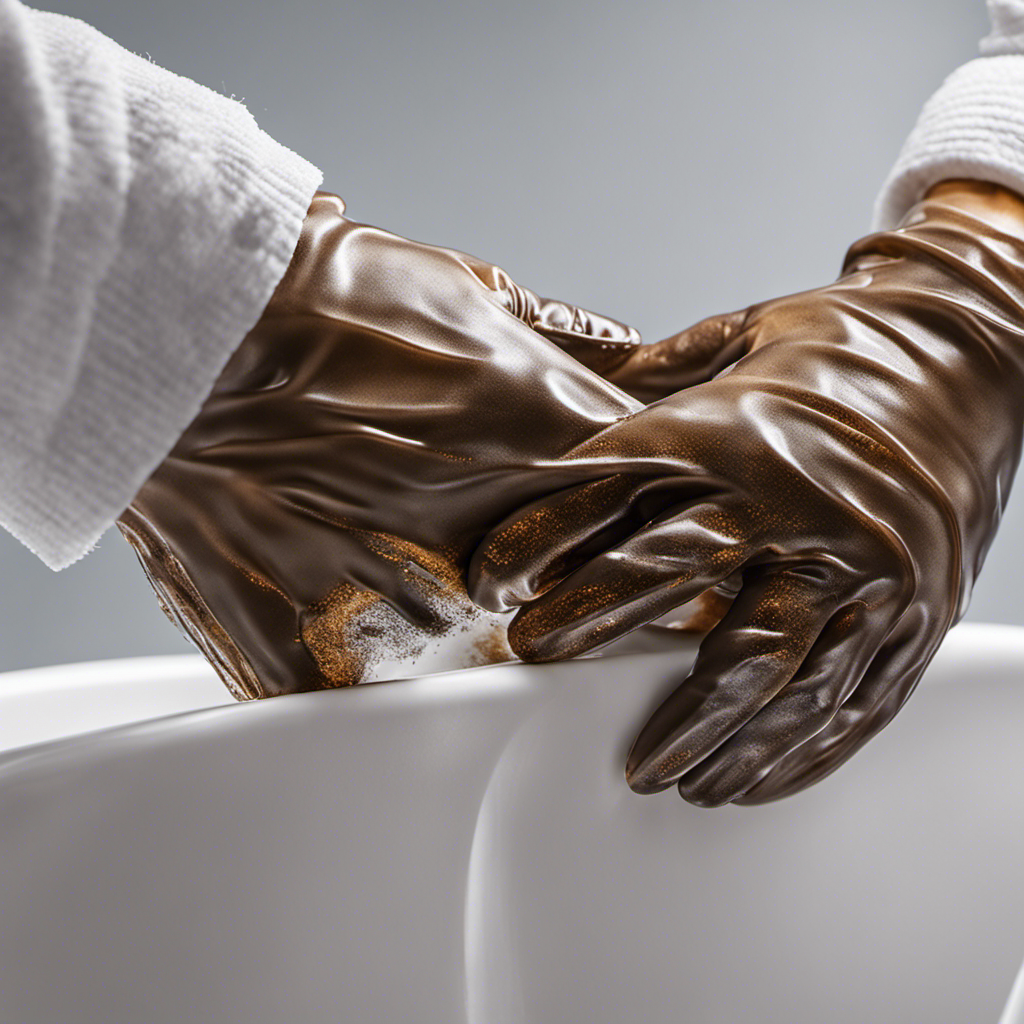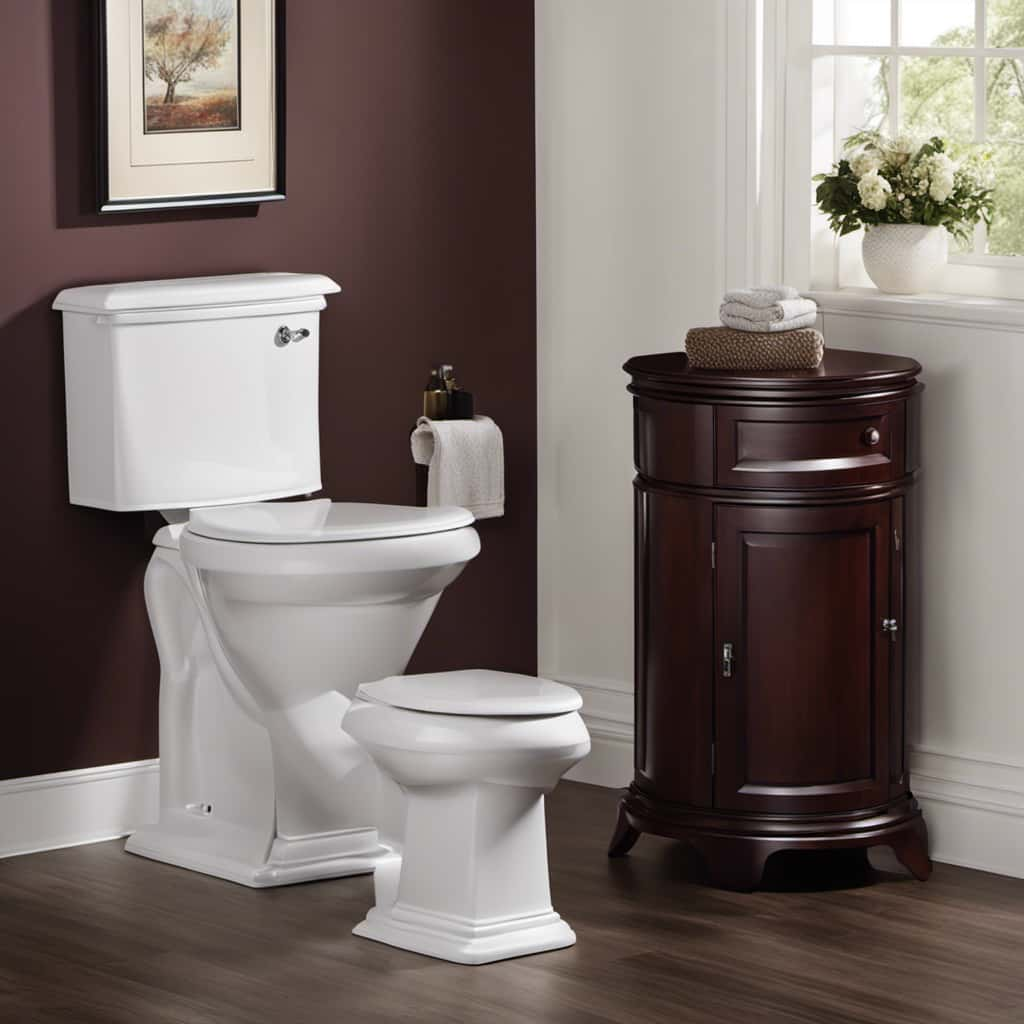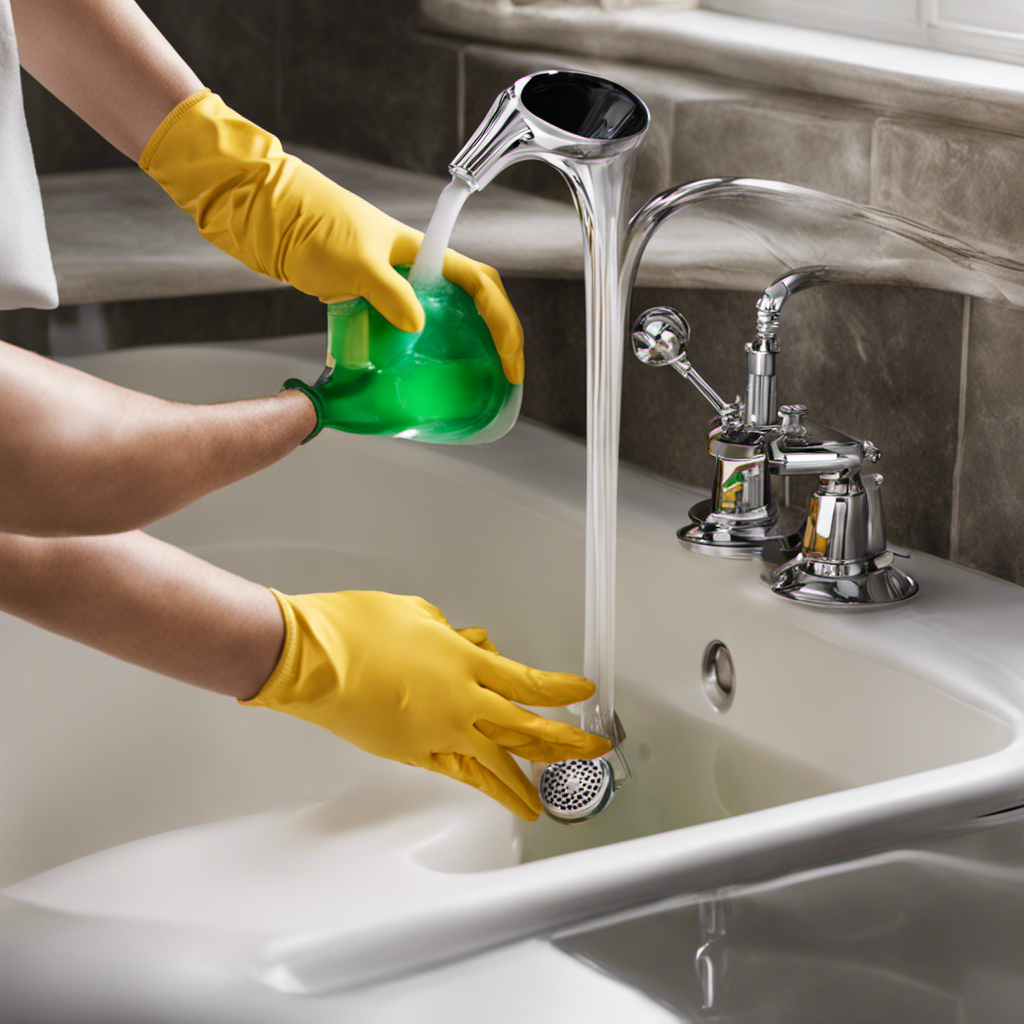So, you’ve noticed a chip in your bathtub. Not exactly the relaxing oasis you were hoping for. But fear not, because in this article, we’re going to show you how to fix that chip like a pro.
With a little bit of time and effort, you can have your bathtub looking as good as new. So grab your materials and let’s get started on this DIY project that will leave you feeling accomplished and your bathtub chip-free.
Key Takeaways
- Assess the size, depth, and causes of the chip and determine the extent of the damage for appropriate repair.
- Choose an epoxy repair kit that matches the color of the bathtub and wear safety gloves during the repair process.
- Use fine-grit sandpaper to smooth the edges of the chip and create a rough surface for better adhesion of the filler.
- Apply the filler in thin layers, allowing each layer to dry before adding another, and follow the manufacturer’s instructions for curing time.
Assess the Damage
You’ll need to carefully examine the chip in your bathtub to assess the extent of the damage. Assessing the damage is crucial in determining the appropriate fix for your bathtub chip.
Start by inspecting the size and depth of the chip. Is it a small, superficial chip, or a larger one that extends deep into the surface?
Next, identify the causes of the chip. It could be due to impact from a heavy object, abrasive cleaning techniques, or even natural wear and tear. Look for any signs of cracking or discoloration around the chip, as these can provide clues about the underlying issues.
Gather Necessary Materials
When it comes to repairing a chip in your bathtub, it’s essential to know the right materials to use, as well as the proper application techniques.
Choosing the right materials is crucial to ensure a durable and long-lasting repair.
Repairing the Chip
To repair the chip in the bathtub, start by gathering the necessary materials. You’ll need the following items:
- Epoxy repair kit: Look for a kit that matches the color of your bathtub to ensure a seamless repair.
- Safety gloves: Protect your hands from any chemicals in the repair kit.
- Sandpaper: Use a fine-grit sandpaper to smooth the edges of the chip before applying the epoxy.
- Putty knife: This will help you apply the epoxy evenly and remove any excess.
- Clean cloth: Use a clean cloth to wipe away any dust or debris from the surface of the bathtub.
When choosing the right color for the epoxy, make sure to match it as closely as possible to your bathtub’s original color. This will help the repair blend in seamlessly.
If the chip is deep, fill it with the epoxy using a putty knife, making sure to level it with the surrounding surface. Allow the epoxy to dry completely before using the bathtub again.
Choosing the Right Materials
Choosing the right materials for the repair is essential to ensure a seamless blend with the original color of the bathtub. When it comes to fixing a chip in your bathtub, there are a few key factors to consider. First and foremost, you need to choose the right filler for the job. Look for a filler specifically designed for repairing bathtubs, as these will have the necessary durability and waterproof properties. Additionally, proper sanding techniques are crucial to achieving a smooth and even surface. Before applying the filler, make sure to sand the damaged area with fine-grit sandpaper, creating a rough surface for the filler to adhere to. This will help ensure a strong bond and a professional-looking repair. Remember, attention to detail and using the correct materials will result in a bathtub that looks as good as new.
| Choosing the Right Filler | Proper Sanding Techniques |
|---|---|
| Look for a filler specifically designed for repairing bathtubs | Sand the damaged area with fine-grit sandpaper |
| Ensure durability and waterproof properties | Create a rough surface for the filler to adhere to |
| Achieve a seamless blend with the original color | Create a strong bond for a professional-looking repair |
Proper Application Techniques
Using a putty knife, gently spread the filler over the damaged area to ensure a smooth and even application. This is one of the proper application techniques for fixing a chip in a bathtub.
To further assist you in achieving the best results, here are some additional tips:
- Apply the filler in thin layers, allowing each layer to dry before adding another. This helps avoid cracking and promotes better adhesion.
- Use a sandpaper or sanding sponge to smooth out any rough edges or uneven surfaces before applying the filler.
- Make sure to follow the manufacturer’s instructions regarding drying times and curing process.
- Apply a waterproof sealant over the repaired area to prevent moisture damage and prolong the longevity of the repair.
- Regularly clean and maintain the repaired area to prevent further damage or chipping.
Clean the Chip
After you’ve gathered the necessary materials, start by cleaning the chip in your bathtub. Use a mild cleaning product specifically designed for bathtubs to ensure that you remove any dirt or grime that might be present. Apply the cleaning product to a soft cloth or sponge and gently scrub the chip, making sure to cover the entire area.
Rinse the area thoroughly with water to remove any residue from the cleaning product. Cleaning the chip is an essential step in the chip repair process because it allows for better adhesion of the repair material. By removing any dirt or grime, you ensure that the repair will be long-lasting and effective.
Additionally, regularly cleaning your bathtub with appropriate cleaning products can help prevent chips from occurring in the first place.
Prepare the Bathtub Surface
To get started, make sure you’ve thoroughly cleaned the surface of your tub before proceeding with the next step. Surface preparation is crucial to ensure a proper bond between the repair material and the bathtub. Here are some key steps to follow for effective surface preparation:
-
Clean the surface: Remove any dirt, grime, or soap residue using a non-abrasive cleaner and a sponge or cloth. Rinse thoroughly and allow the tub to dry completely.
-
Sand the area: Use fine-grit sandpaper to gently sand the chipped area and its surroundings. This will create a rough surface for better adhesion.
-
Remove any loose material: Use a brush or vacuum to remove any loose debris or particles from the chipped area.
-
Apply a primer: Apply a thin coat of primer designed for bathtub repairs to the chipped area. This will promote adhesion and enhance the durability of the repair.
-
Allow proper drying time: Follow the manufacturer’s instructions on the primer’s drying time before moving on to the next step.
Apply Epoxy Filler
When it comes to bathtub repair, there are alternative methods you can consider that can effectively fix any issues you may have.
One such method is the use of long-lasting epoxy solutions, which can provide a durable and reliable fix for various bathtub problems. These epoxy solutions are known for their ability to bond strongly to the bathtub surface, ensuring a lasting repair that can withstand everyday use.
Alternative Bathtub Repair Methods
If you’re looking for a quick and affordable solution, you might want to consider using a bathtub repair kit to fix the chip in your bathtub. These kits are easily available and come with everything you need to repair the chip yourself.
Here are some alternative repair methods and temporary fixes you can try before resorting to a full bathtub replacement:
- Use acrylic or enamel paint to touch up the chip.
- Apply a clear epoxy resin to fill in the chip.
- Utilize a bathtub repair putty to cover the chip.
- Use a bathtub refinishing kit to restore the surface of the chip.
- Apply a bathtub repair patch to cover the chip.
While these methods provide temporary fixes, they may not be as long-lasting as epoxy solutions. Speaking of which, let’s explore the benefits of using long-lasting epoxy solutions to fix the chip in your bathtub.
Long-Lasting Epoxy Solutions
Using long-lasting epoxy solutions can provide a durable and reliable way to repair the damage in your bathtub. Epoxy fillers are a popular choice for bathtub repair due to their strength and longevity. They can effectively fill in cracks, chips, and other imperfections, restoring the appearance and functionality of your bathtub. While epoxy fillers are known for their durability, there are also alternative long-lasting epoxy options available in the market. These alternatives offer similar benefits but may have different application methods or drying times. It’s important to weigh the pros and cons of epoxy fillers before making a decision. Here is a table summarizing the advantages and disadvantages of using epoxy fillers:
| Pros | Cons |
|---|---|
| Durable | Requires proper mixing and application |
| Long-lasting | May have a strong odor during application |
| Easy to apply | Can be difficult to remove once cured |
| Versatile | May require multiple layers for optimal results |
Smooth Out the Filler
To smooth out the filler, you’ll want to use a fine-grit sandpaper. This will help you achieve a seamless finish and ensure that the repaired area blends in with the rest of the bathtub’s surface.
Here are five important tips to keep in mind when smoothing out the filler:
- Begin by sanding the patched up area gently in circular motions to remove any excess filler and create a smooth surface.
- Use a sanding block or sandpaper wrapped around a small piece of wood to maintain an even pressure and prevent uneven sanding.
- Gradually work your way from coarse to finer grit sandpaper, starting with a 120-grit and finishing with a 240-grit or higher for a polished finish.
- Keep the sandpaper clean and free from debris by frequently tapping it against a hard surface or using a sandpaper cleaning brush.
- Finally, wipe down the sanded area with a damp cloth or sponge to remove any dust or residue before applying the final finish.
Let the Filler Cure
Once you have applied the filler, it is important to let it cure for the recommended amount of time. This step is crucial to ensure that the filler hardens properly and achieves optimal strength. Curing time can vary depending on the brand and type of filler used, so it is essential to refer to the manufacturer’s instructions. Rushing the curing process can result in a weaker repair that may not last as long. To help you understand the importance of curing time, here is a table that highlights the recommended curing times for some common filler brands:
| Filler Brand | Recommended Curing Time |
|---|---|
| Brand A | 24 hours |
| Brand B | 48 hours |
| Brand C | 72 hours |
Sand the Filler
When it comes to sanding the filler on your bathtub chip repair, proper techniques are crucial to achieving a smooth and seamless finish. You want to ensure that you have the right tools and know-how to sand effectively without causing any damage to the surrounding area.
Additionally, choosing the right filler for the job is equally important as it will determine the durability and longevity of your repair. Taking the time to research and select the appropriate filler will save you from potential future problems and ensure a successful bathtub chip repair.
Proper Sanding Techniques
Using a fine-grit sandpaper will help smooth out the chip in your bathtub. When it comes to proper sanding techniques, there are a few key things to keep in mind.
First, make sure you are using the right type of sandpaper for the job. A fine-grit sandpaper, such as 220-grit, is ideal for smoothing out the surface without causing further damage.
Second, apply even pressure while sanding to avoid creating uneven areas.
Third, use long, smooth strokes in the direction of the grain to achieve the best results.
Fourth, be careful not to oversand the area, as this can lead to thinning the surrounding surface.
Finally, always clean the area thoroughly after sanding to remove any dust or debris.
Choosing the Right Filler
Now that you have properly sanded the chipped area of your bathtub, it’s time to choose the right filler to apply. Applying the filler correctly is crucial to achieving a seamless repair.
There are several popular filler options available for repairing chips in a bathtub. One common option is a two-part epoxy filler, which is durable and resistant to water. Another option is a polyester resin filler, which is easy to work with and provides a smooth finish. Alternatively, you can use a bathtub repair kit that includes a filler specifically designed for this purpose.
Whatever filler option you choose, make sure to carefully follow the manufacturer’s instructions for mixing and applying it. Once you have selected and applied the filler, you can move on to the next step of applying a topcoat to ensure a long-lasting repair.
Apply a Topcoat
To ensure a smooth and even finish, it’s important to apply a topcoat to the repaired chip in the bathtub. The topcoat application not only enhances the overall appearance of the repair, but also provides added protection to the surface. Here are the benefits of applying a topcoat:
-
Increased durability: The topcoat forms a tough and resilient layer that helps protect the repaired area from daily wear and tear.
-
Improved water resistance: By sealing the repaired chip with a topcoat, you prevent water from seeping into the surface, reducing the risk of further damage.
-
Enhanced color matching: The topcoat can be tinted to match the color of your bathtub, ensuring a seamless repair that blends in perfectly.
-
Smoother texture: Applying a topcoat helps to level out any unevenness in the repaired area, resulting in a smoother and more polished finish.
-
Long-lasting results: The topcoat acts as a barrier, prolonging the lifespan of the repair and maintaining its aesthetic appeal.
With the topcoat applied, you can now move on to the next step: buff and polish.
Buff and Polish
For a smooth and shiny finish, gently buff and polish the repaired area after applying the topcoat.
Buffing and polishing are crucial steps in the bathtub chip repair process, as they help to blend the repaired area seamlessly with the rest of the surface.
To begin, gather your buffing materials, including a buffing pad or cloth and a polishing compound. Apply a small amount of the compound to the pad or cloth and gently rub it onto the repaired area in circular motions.
This will help to remove any imperfections and bring out the shine. Be sure to use light pressure and avoid over-buffing, as this can damage the surface.
Once you are satisfied with the result, wipe away any excess compound and admire your smooth and shiny bathtub repair.
Maintain and Prevent Future Chips
Regular maintenance is essential for preventing future chips and keeping your bathtub in good condition. By following a few simple steps, you can ensure that your bathtub stays chip-free and maintains its pristine appearance. Here are some preventive maintenance tips for DIY bathtub repair:
- Clean your bathtub regularly with a non-abrasive cleaner to remove dirt and grime that can lead to chips.
- Use a soft sponge or cloth when cleaning to avoid scratching the surface of the bathtub.
- Avoid using harsh chemicals or abrasive scrubbers that can damage the enamel or acrylic coating.
- Install non-slip mats or adhesive strips to prevent slips and falls, which can cause chips and cracks.
- Repair any minor chips or scratches promptly using a DIY bathtub repair kit to prevent them from worsening over time.
Frequently Asked Questions
Can I Use Regular Household Cleaners to Clean the Chip in the Bathtub?
You can’t use regular household cleaners to fix the chip in your bathtub. However, there are preventive measures you can take to protect your tub and alternative cleaning methods specifically designed for chip repairs.
How Long Does the Epoxy Filler Take to Cure?
To properly apply epoxy filler and prepare the bathtub surface, you’ll need to follow these steps. First, clean the area thoroughly. Then, mix the epoxy filler according to instructions and carefully apply it. The curing time can vary, so check the product label for specific guidelines.
What Type of Topcoat Should I Use on the Repaired Chip?
To protect your repaired chip, choose a topcoat that acts as a shield for your bathtub, like armor for a warrior. Consider options like epoxy or enamel, following best practices for bathtub chip repair.
How Often Should I Buff and Polish the Bathtub to Maintain Its Appearance?
To maintain the appearance of your bathtub, it is recommended to buff and polish it regularly. This helps prevent further chips and keeps it looking shiny and new. Alternative repair methods and common causes of chips should also be considered.
Are There Any Preventive Measures I Can Take to Avoid Future Chips in the Bathtub?
To prevent future chips in your bathtub, be cautious when using heavy objects near it and avoid dropping anything hard or sharp. Regular maintenance and refinishing techniques can also help maintain the appearance and durability of your bathtub. Consider hiring professional bathtub repair services for any repairs or refinishing needs.
Conclusion
Now that you’ve followed these steps, your bathtub is as good as new! The chip has been seamlessly repaired, leaving behind no traces of its existence.
Your bathtub shines like a polished gem, reflecting the light and adding a touch of elegance to your bathroom.
With proper maintenance and caution, you can ensure that your bathtub remains chip-free, standing strong against the test of time.
So go ahead, relax and enjoy your pristine bathtub oasis.










